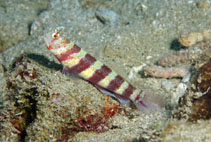| Family: |
Gobiidae (Gobies), subfamily: Gobiinae |
| Max. size: |
10 cm SL (male/unsexed) |
| Environment: |
reef-associated; marine; depth range 5 - 40 m |
| Distribution: |
Indo-Pacific: East Africa to Fiji, north to southern Japan, south to the Great Barrier Reef. |
| Diagnosis: |
Dorsal spines (total): 7-7; Dorsal soft rays (total): 12-12; Anal spines: 1-1; Anal soft rays: 12-12. Characterized by whitish to pale yellow body color with seven reddish brown to red bars; head and body with blue spots and sometimes on median fins; scattered red spots on head including corner of mouth; medially united pelvic fins for nearly half length of fifth ray; predorsal scales extending forward to above posterior margin of preopercle; longitudinal scale series 50-58; greatest depth of body 4.5-5.2 in SL; rounded caudal fin, slightly longer than head (Ref. 90102). |
| Biology: |
Apparently the most common shallow-water species of the genus found in coral reef areas, but may occur at depths greater than 30 m. Usually found in rubble areas near or within coral reefs and in symbiotic association with alpheid shrimps, most often with Alpheus ochrostriatus. Found in coastal sand slopes and deep lagoons, shallow to 40 meters depth range (Ref. 48637). |
| IUCN Red List Status: |
Least Concern (LC); Date assessed: 11 March 2015 Ref. (130435)
|
| Threat to humans: |
harmless |
Source and more info: www.fishbase.org. For personal, classroom, and other internal use only. Not for publication.
